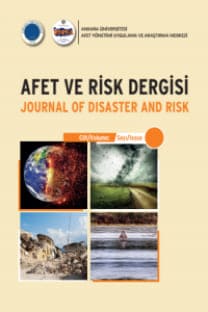Flood and Earthquake as Punishment of Gods in Antiquity
Antiquity, Disaster, Earthquake, Flood, Gods’ Judgment, Social Anthropology
Flood and Earthquake as Punishment of Gods in Antiquity
Antiquity, Disaster, Earthquake, Flood, Gods’ Judgment, Social Anthropology,
___
- Akyüz D (2018). M.Ö. 2. Binyıl Anadolu Coğrafyasında Yaşanmış Doğal Afetler ve Salgın Hatalıklar. Yüksek Lisans Tezi, Sinop Üniversitesi.
- Altun I, Çınaroğlu M (2020). Tarihin Sonu Olgusu ve Eskatologya Mitleri. Millî Folklor 128: 28-40. https://dergipark.org.tr/tr/pub/millifolklor/issue/58685/798838
- Agizza R (2001). Antik Yunanda Mitoloji. İstanbul: Arkeoloji ve Sanat Yayınları.
- Berlejung A (2015). Sin and Punishment: The Ethics of Divine Justice and Retribution in Ancient Near Eastern and Old Testament Texts. A Journal of Bible and Theology 69/3: 272 –287. 10.1177/0020964315578205.
- Çevirme H (2020). A Cultural Approach to Earthquake Coping Strategies: Examples of Turkish Folk Poems and Memorates. Motif Akademi Halkbilimi Dergisi13/31: 1073-1087. https://doi.org/10.12981/mahder.764467
- Dietrich J (2015). Coping with Disasters in Antiquity and the Bible: Practical and Mental Strategies. In I F. Riede (ed) Past Vulnerability: Volcanic eruptions and human vulnerability in traditional societies past and present. Aarhus Universitetsforlag, pp 151-167.
- Erhat A (1996). Mitoloji Sözlüğü. İstanbul: Remzi Kitabevi.
- Fisher EA, Hadley RA (1979). Two ancient accounts of the eruption of Vesuvius in A.D. 79. In: Pompeii and the Vesuvian landscape: papers of a symposium sponsored by The Archaeological Institute of America, Washington Society and The Smithsonian Institution. The Archaeological Institute of America, Washington, DC, pp 9–15.
- Grandjean D, Rendu AC, MacNamee T, Scherer K R (2008). The Wrath of the Gods: Appraising the Meaning of Disaster. Social Science Information 47/2: 187–204. 10.1177/0539018408089078.
- Higgins CM (2009). Popular and Imperial Response to Earthquakes in the Roman Empire. Yüksek Lisans Tezi, College of Arts and Sciences of Ohio University, Ohio.
- Homer (1990). The Iliad. New York, N.Y: Viking. --- (1991). The Odyssey of Homer. New York: Harper Perennial.
- Jean C (2010). Divination and Oracles at the Neo-Assyrian Palace: The Importance of Signs in Royal Ideology, Divination and Interpretation of Signs in the Ancient World, Chicago: The Oriental Institute of the University of Chicago.
- Laoupi A (2006). The Greek Myth of Pleiades in the Archaeology of Natural Disasters. Decoding, Dating and Environmental Interpretation. Mediterranean Archaeology and Archaeometry 6/2: 5-22.
- Lee HW (2011). Biblical Understandings of Natural Disasters and Applications for the Christian Ministry. TTJ 14/1:38-57. ISSN 1598-7140
- Liritzis I, Westra A, Miao C (2019). Disaster Geoarchaeology and Natural Cataclysms in World Cultural Evolution: An Overview. Journal of Coastal Research 35/6: 1307–1330. 10.2112/JCOASTRES-D-19-00035.1.
- Mandacı E (2020). Asur Devleti’nde Doğal Afetler ve Doğal Afet Algısı. Trakya Üniversitesi Sosyal Bilimler Dergisi 22/1: 99-116. https://doi.org/10.26468/trakyasobed.524554
- Molesky M (2015). This Gulf of Fire: The Great Lisbon Earthquake, or Apocalypse in the Age of Science and Reason. New York: Vintage.
- O’Mathúna DP (2018). Christian Theology and Disasters: Where is God in All This? In: O’Mathúna, D., Dranseika, V., Gordijn, B. (ed) Disasters: Core Concepts and Ethical Theories. Advancing Global Bioethicsvol 11. Springer, pp 27-42.
- OldTestiment. https://www.churchofjesuschrist.org/bc/content/shared/content/english/pdf/language-materials/83290_eng.pdf (Son Erişim: 03.01.2023)
- Ovid, Metamorphoses. http://classics.mit.edu/Ovid/metam.html (Son Erişim: 04.01.2023
- Patterson DJ (2013). Adversus paganos: Disaster, Dragons, and Episcopal Authority in Gregory of Tours Comitatus: A Journal of Medieval and Renaissance Studies 44: 1-28. Plato (1961) Timaeus, Critias, Cleitophon, Menexenus, Epistles, edited by R.G. Bury. London: The Loeb Classical Library.
- Şahin Ö (2019). Antik Çağ’dan Orta Çağ’a Kadar Depremlerin Oluşumuna İlişkin Öne Sürülen Teoriler Mavi Gezegen 27: 8-13.
- https://www.jmo.org.tr/resimler/ekler/bc7aaa0000799b9_ek.pdf (Son Erişim: 16.12.2022) Thucydides (1954). History of the Peloponnesian War. Baltimore: Penguin Books.
- Yayın Aralığı: 4
- Başlangıç: 2018
- Yayıncı: Ankara Üniversitesi
Denizcilik Alanında Kullanılan Risk Analizi Yöntemleri ve Fine Kinney Yöntemiyle Bir Uygulama
Türkiye Deprem Bölgeleri Haritalarının Tarihsel Gelişimi ve Ankara’ya Etkileri
Flood and Earthquake as Punishment of Gods in Antiquity
İstanbul İlçe Belediyelerinde Sivil Savunma Birimlerinin Yapısal ve İşlevsel İncelemesi
Flood Inundation Mapping for Porsuk Stream, Eskişehir, Turkey
Mustafa Murat KALE, Murat ATAOL
The Mediating Effect of Religious Attitude on the Relationship Between Mindfulness and Covid-19 Fear
Hizan ve Çevresinin (Bitlis) Drenaj Ağı Özellikleri, Yüzeysel Suları ve Çevresel Riskleri
Bülent MATPAY, Ali Fuat DOĞU, Mehmet Akif SEYİTOĞULLARI
Ulusal Endüstriyel Kazalar Etki Alanı Modellemesi Yazılımı (AFAD-EKA)
Mehmet Fatih ŞEN, Betül KURADA, Evren TANRIVERDİ
Su Krizini Çerçevelemek: Halkla İlişkiler Pratiği Olarak Çevre Sponsorluğu
Afet Bilinci ve Stresli Durumlarla Başa Çıkma Arasındaki İlişkinin Belirlenmesi
